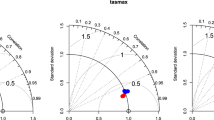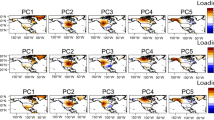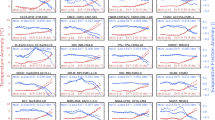Abstract
The global climate has been experiencing significant warming at an unprecedented pace in the past century1,2. This warming is spatially and temporally non-uniform, and one needs to understand its evolution to better evaluate its potential societal and economic impact. Here, the evolution of global land surface air temperature trend in the past century is diagnosed using the spatial–temporally multidimensional ensemble empirical mode decomposition method3. We find that the noticeable warming (>0.5 K) started sporadically over the global land and accelerated until around 1980. Both the warming rate and spatial structure have changed little since. The fastest warming in recent decades (>0.4 K per decade) occurred in northern mid-latitudes. From a zonal average perspective, noticeable warming (>0.2 K since 1900) first took place in the subtropical and subpolar regions of the Northern Hemisphere, followed by subtropical warming in the Southern Hemisphere. The two bands of warming in the Northern Hemisphere expanded from 1950 to 1985 and merged to cover the entire Northern Hemisphere.
This is a preview of subscription content, access via your institution
Access options
Subscribe to this journal
Receive 12 print issues and online access
$209.00 per year
only $17.42 per issue
Buy this article
- Purchase on Springer Link
- Instant access to full article PDF
Prices may be subject to local taxes which are calculated during checkout



Similar content being viewed by others
References
IPCC Climate Change 2007: The Physical Science Basis (eds Soloman, S. et. al) (Cambridge Univ. Press, 2007).
IPCC Climate Change 2013: The Physical Science Basis (eds Stocker, T. F. et. al) (Cambridge Univ. Press, 2013).
Wu, Z., Huang, N. E. & Chen, X. The multi-dimensional ensemble empirical mode decomposition method. Adv. Adapt. Data Anal. 1, 339–372 (2009).
Hansen, J., Ruedy, R., Sato, M. & Lo, K. Global surface temperature change. Rev. Geophys. 48, RG4004 ( 2010).
Lawrimore, J. H. et al. An overview of the global historical climatology network monthly mean temperature data set, version 3. J. Geophys. Res. 116, D19121 (2011).
Wu, Z., Huang, N. E., Long, S. R. & Peng, C-K. On the trend, detrending and variability of nonlinear and non-stationary time series. Proc. Natl Acad. Sci. USA 104, 14889–14894 (2007).
Huang, N. E. et al. The empirical mode decomposition method and the Hilbert spectrum for non-stationary time series analysis. Proc. R. Soc. Lond. A. 454, 903–995 (1998).
Huang, N. E. & Wu, Z. A review on Hilbert–Huang transform: The method and its applications on geophysical studies. Rev. Geophys. 46, RG2006 (2008).
Wu, Z. & Huang, N. E. Ensemble empirical mode decomposition: A noise-assisted data analysis method. Adv. Atmos. Sci. 1, 1–41 (2009).
Wu, Z., Huang, N. E., Wallace, J. M., Smoliak, B. V. & Chen, X. On the time-varying trend in global-mean surface temperature. Clim. Dynam. 37, 759–773 (2011).
Franzke, C. Multi-scale analysis of teleconnection indices: Climate noise and nonlinear trends analysis. Nonlinear Proc. Geoph. 16, 65–76 (2009).
Ruzmaikin, A. & Feynman, J. Search for climate trends in satellite data. Adv. Adapt. Data Anal. 1, 667–679 (2009).
Qian, C., Wu, Z., Fu, C. B. & Zhou, T. J. On multi-timescale variability of temperature in China in modulated annual cycle reference frame. Adv. Atmos. Sci. 27, 1169–1182 (2010).
Vecchio, A. & Carbone, V. Amplitude–frequency fluctuations of the seasonal cycle, temperature anomalies, and long-range persistence of climate records. Phys. Rev. E. 82, 066101 (2010).
Franzke, C. & Woollings, T. On the persistence and predictability properties of North Atlantic climate variability. J. Clim. 24, 466–472 (2011).
Fu, C., Qian, C. & Wu, Z. Projection of global mean surface air temperature changes in next 40 years: Uncertainties of climate models and an alternative approach. Sci. China Earth Sci. 54, 1400–1406 (2011).
Hu, Z. Z., Huang, B., Kinter, J. L. III, Wu, Z. & Kumar, A. Connection of the stratospheric QBO with global atmospheric general circulation and tropical SST Part II: Interdecadal variations. Clim. Dynam. 38, 25–43 (2012).
Huang, B. et al. Influences of subtropical air–sea interaction on the multidecadal AMOC variability in the NCEP climate forecast system. Clim. Dynam. 39, 631–555 (2012).
Zhu, J., Huang, B. & Wu, Z. The role of ocean dynamics in the interaction between the Atlantic meridional and equatorial modes. J. Clim. 25, 3583–3598 (2012).
Misra, V., Li, H., Wu, Z. H. & DiNapoli, S. Global seasonal climate predictability in a two tiered forecast system: Part I: Boreal summer and fall seasons. Clim. Dynam. 42, 1425–1448 (2014).
Mitchell, T. D. & Jones, P. D. An improved method of constructing a database of monthly climate observations and associated high-resolution grids. Int. J. Climatol. 25, 693–712 (2005).
Semenov, V. A. et al. The impact of North Atlantic–Arctic multidecadal variability on Northern Hemisphere surface air temperature. J. Clim. 23, 5668–5677 (2010).
DelSole, T., Tippett, M. K. & Shukla, J. A significant component of unforced multidecadal variability in the recent acceleration of global warming. J. Clim. 24, 909–926 (2011).
Booth, B. B., Dunstone, N. J., Halloran, P. R., Andrews, T. & Bellouin, N. Aerosols implicated as a prime driver of twentieth-century North Atlantic climate variability. Nature 484, 228–232 (2012).
Tung, K. K. & Zhou, J. Using data to attribute episodes of warming and cooling in instrumental records. Proc. Natl Acad. Sci. USA 110, 2058–2063 (2013).
Zhang, R. et al. Have aerosols caused the observed Atlantic multidecadal variability? J. Atmos. Sci. 70, 1135–1144 (2013).
Hudson, R. D., Andrade, M. F., Follette, M. B. & Frolov, A. D. The total ozone field separated into meteorological regimes–Part II: Northern Hemisphere mid-latitude total ozone trends. Atmos. Chem. Phys. 6, 5183–5191 (2006).
Hu, Y. & Fu, Q. Observed poleward expansion of the Hadley circulation since 1979. Atmos. Chem. Phys. 7, 5229–5236 (2007).
Seidel, D. J., Fu, Q., RanDel, W. J. & Reichler, T. J. Widening of the tropical belt in a changing climate. Nature Geosci. 1, 21–24 (2008).
Huang, J., Guan, X. & Ji, F. Enhanced cold-season warming in semi-arid regions. Atmos. Chem. Phys. 12, 5391–5398 (2012).
Acknowledgements
This work was supported by the National Basic Research Program of China 2012CB955301 (F.J. and J.H.) as well as the US National Science Foundation program AGS-1139479 (Z.W. and F.J.).
Author information
Authors and Affiliations
Contributions
All authors contributed to shaping up the ideas and writing the paper. The analyses were carried out by F.J. and Z.W., with various analysis methods designed by Z.W., F.J. and Z.W. are co-first authors.
Corresponding author
Ethics declarations
Competing interests
The authors declare no competing financial interests.
Supplementary information
Rights and permissions
About this article
Cite this article
Ji, F., Wu, Z., Huang, J. et al. Evolution of land surface air temperature trend. Nature Clim Change 4, 462–466 (2014). https://doi.org/10.1038/nclimate2223
Received:
Accepted:
Published:
Issue Date:
DOI: https://doi.org/10.1038/nclimate2223
This article is cited by
-
Asymmetric Drying and Wetting Trends in Eastern and Western China
Advances in Atmospheric Sciences (2024)
-
Reliance on fossil fuels increases during extreme temperature events in the continental United States
Communications Earth & Environment (2023)
-
Spatial patterns of climate change and associated climate hazards in Northwest China
Scientific Reports (2023)
-
Reversed asymmetric warming of sub-diurnal temperature over land during recent decades
Nature Communications (2023)
-
Temperature fluctuation promotes the thermal adaptation of soil microbial respiration
Nature Ecology & Evolution (2023)



